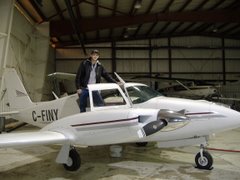If you were to compare an aircraft engine with an automobile engine you would notice that they operate on the same basic principle - a 4 stroke gasoline powered piston engine. However that's about where the similarities end.
My Twin Comanche is equipped with Lycoming IO-320's. All those letters and numbers mean something, so let me break it down for you. Lycoming is the manufacturer. There are two major aero engine manufacturers, one being Lycoming, and other being Continental. The "I" in the engine model number stands for "Injected", meaning its fuel injected as opposed to carbureted, and "O" means the engine is of the horizontally opposed type (O for Opposed). A horizontally opposed engine is where the cylinders are facing directly away from each other, with the crankshaft running down the middle of the engine. In contrast, a car usually has either an inline engine, meaning the cylinders are all lined up in a row, or a V engine, meaning the cylinders are lined up opposite each other (line a horizontally opposed engine), except with a slight upward angle, so if you look from front to back the cylinders make a V shape. The 320 in the model number is the displacement of the engine in cubic inches.
So if we have an IO-320, that means we have a fuel injected, horizontally opposed, 320 cubic inch engine. In this case, its a four cylinder. The model number does not tell you how many cylinders it has, but usually judging by the displacement size you can figure it out. For some of you automobile engine savvy readers, you may be thinking, "Holy crap! 320 cubic inches is a ton of displacement for only a 4 banger!". You would be correct, that's huge. GM has V-8 engines with only a displacement of 305 or 350 cubic inches, and those are considered big engines. The old Ford Mustang has its famous 5.0L engine (302 cubic inches). In the case of aero engines, my IO-320's are considered small. Many slightly larger light twins are equipped with IO-540's (meaning 540 cubic inches).
You might also find it perplexing when you compare the horsepower between the two engines. My IO-320's output only 160 HP each. When you compare it to GM's 350 V-8, which has been known to output easily over 300 HP in many cases, and is not much larger in displacement then the IO-320, there's quite a difference. So what gives then?
The principle reason why the output seems so low on such relatively huge aircraft engines is simple - its the speed at which the engine turns. Car engines can easily rev up to 5000-6000 RPM with no problems whatsover. However an engine spinning a prop doesn't have that luxury. For weight and simplicity reasons, the vast majority of aero engines are directly linked to the propeller - no transmission, no reduction gears. The prop will spin at the same speed as the engine. If a propeller was spinning as fast as an automobile engine does, the tips of the props would be breaking the speed of sound. When something breaks the speed of sound, in a nutshell, a shockwave is produced creating turbulent air around the object. I could go into the physics of that, but for now we just have to know that this can't really be allowed to happen. This is also to assume that the propeller wouldn't shred itself spinning at 6000 RPM.
This means that propellers, and thus aero engines are limited to relatively low RPMs. Therefore aero engines are built to produce lots of power at low RPMS (2700 RPM is usually redline). That's where the massive displacement comes in. Engines with fewer cylinders that are much larger can produce lots more power at low RPMs then something with smaller cylinders but more of them.
I've wondered how this affects fuel economy, but it would be difficult to make that comparison without actual testing, because fuel economy is measured differently with airplanes and cars, and the way the engines are operated are completely different as well. Airplanes for the most part have a completely constant power setting once cruise is reached, whereas a car is always stop and go, even on a highway you have to make slight adjustments to maintain your speed when going up and down hills, and this has a very large factor on fuel economy.
So there's some food for thought, maybe next post I'll continue on what else makes aero engines different then automobile engines.
Subscribe to:
Post Comments (Atom)




Hey, this was really good. I learned more from this than any other blog you've written primarily because you're approaching it from a perspective I understand. I always thought the IO was just part of the model number with little or no meaning. Anxious to hear the rest of it.
ReplyDeleteThe part on HP vs. RPM was very helpful. Thanks.
ReplyDeleteVery interesting article, although I don't like to buy cars with out a Marshall Engine.
ReplyDeleteA1 Wreckers Cash For Scrap Cars and Car Removals Brisbane offers you the cash for cars and affordable second hand part shopping experience. Whether you want a spare car part or want to sell your junk car, you won’t be disappointed with us.
ReplyDeletecreativity of writer is purely impressive. It has touched to the level of expertise with his writing. Everything is up to the mark. Written perfectly and I can use such information for my coming assignment.vehicle history check
ReplyDelete